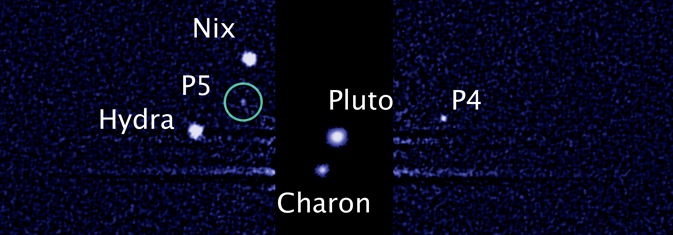¡SkyCaramba! Weekly astronomy blog for the week ending July 21, 2012
For an object that’s not even thought of as a planet anymore, Pluto sure gets a lot of attention. That attention has led to the discovery of a fifth object orbiting Pluto. Only the first three objects orbiting icy Pluto have names. Those discovered last year and this year still have uninspiring number and letter designations.
Pluto, named for the Greek god of the underworld, was discovered in 1930. In an era when astronomers were looking for a ninth planet with enough mass to tug at Uranus and Neptune, the public was quick to accept the object Clyde Tombaugh spotted as the one. Asteroids were called minor planets in those days, so even after scientists figured out how small Pluto is, nobody seemed to mind calling it a planet too.
Pluto doesn’t have enough mass to bother Uranus and Neptune noticeably. Astronomers now say finding the seventh and eighth planets in slightly different places than expected way back then happened because someone’s calculations weren’t as accurate as they could have been. Even so, scientists like finding out what the universe is made of and how it got to be the way it is. So, some of them keep studying objects like Pluto.
In 1978, highly magnified photographs revealed Pluto has a companion. That surprised a few people. Astronomers had come to think of Pluto as a lost moon, possibly once orbiting Neptune. They didn’t expect it to have a moon itself. The new object got the name Charon. In ancient Greek stories, Charon was an old man who ferried the souls of the dead to the underworld.
In 2005, while controversy arose around whether Pluto really deserves to be called a planet, a team of object hunters using the Hubble Space Telescope discovered two more companions orbiting Pluto. Those became known as Nix and Hydra. Nyx is the ancient Greek goddess of darkness and night. She was the most powerful divine being in those old legends and Charon was her son. When adopting the name for the object orbiting Pluto, the International Astronomical Union deliberately misspelled it Nix to avoid confusion with an asteroid already named Nyx. Hydra’s name comes from the nine-headed serpent that guarded Pluto’s realm. Nobody was concerned that this might be confused with the constellation Hydra.
Now, astronomers have a challenge. An object found last year has the temporary name P4, meaning the fourth object found to orbit Pluto. An object found this year is likewise called P5. But they don’t know what permanent names to give these two satellites. Part of Pluto’s orbit is closer to the sun than Neptune’s. The International Astronomical Union wants to stick with the tradition of naming objects at Neptune’s distance and closer after ancient Greek mythological figures. And since the objects named so far take their names from underworld stories, tradition says P4 and P5 should get such names too.
As eager as some people are to call it something, the discoverers of P4 and P5 get to have their say and they say astronomers should wait. If more moons are discovered, they could all be named as a group from one legend. If you like Greek mythology, you may be able to weigh in on the name selection.
There are more links about this subject below.
¡SkyCaramba!
http://www.space.com/2522-pluto-newest-moons-named-hydra-nix.html
http://www.csmonitor.com/Science/2012/0711/What-should-we-name-Pluto-s-new-moon
http://earthsky.org/space/astronomers-find-new-moon-for-pluto
http://www.scientificamerican.com/article.cfm?id=pluto-moon-p5
http://www.skyandtelescope.com/news/Plutos-Moons-Five-and-Counting-162062385.html
